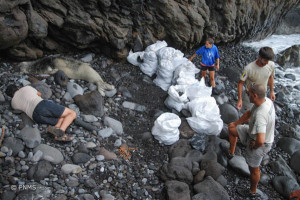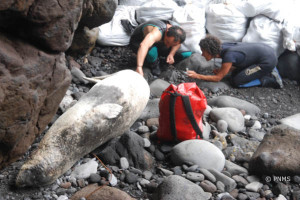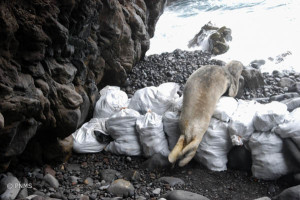by Rosa Pires, Parque Natural da Madeira Service
On 27 August 2013 a Mediterranean monk seal was found in a weakened state at Porto Moniz, on the northern coast of Madeira island.
This seal, known as “Half”, an adult male who has been monitored since 1997 by PNMS (Parque Natural da Madeira Service), was observed by local people on a small stony beach, its debilitated state apparently due to a severe injury in the neck area.
“Half” is one of the most well-known individuals due to its unique coloration, which greatly facilitates identification. Half the body (the anterior area) is dark grey, while the other half is white. Having been observed both in the Desertas Islands and all along the coast of Madeira the animal has the highest movement rate yet recorded.
While the cause of the seal’s injury has not been established, there is the possibility of it having been human inflicted, especially when considering numerous existing reports of hobby fishermen mistreating seals that they see as competitors for fish.
Upon receiving the alert of the wounded seal, a PNMS team travelled to the site to assess the situation. With the support of the Madeira Sea Rescue Association, the Municipality of Port Moniz, Republican National Guard, the Regional Department of Fisheries and the CBD-Habitat Foundation of Spain, a plan of action was set in motion which led first to the creation of a barrier to prevent the seal’s access to the sea. This was necessary to allow a veterinary assessment, and to prevent escape in case “Half” required longer treatment. Following examination, it was decided to administer an intramuscular antibiotic effective for 14 days.
This mission was undertaken with great care to avoid making any decisions that jeopardise the well-being of the seal or even the safety of the people involved.
Surprisingly, after the injection of the antibiotic, “Half” showed a willingness to return to the sea, and even after we opened a way for him, he opted to simply pass over the barrier that had been built throughout the day. It was about 20:00 when he made his way into the sea.
This behaviour suggested that his desire to return to the sea was superior to his weakened state, and as such may be a good sign to his recovery.
So far “Half” has not been seen, though this is not unusual considering the difficulty of monitoring these animals.
The PNMS is staying tuned to the area where “Half” appeared injured and is studying observations of monk seals made by citizens of Madeira in case there are positive sightings of the half-grey, half-white seal.
At this point “Half” may appear anywhere around the island and hopefully it will only be a matter of time before we see him again.
Portugal




Neck injury sounds a familiar sign of seals interaction.
The adult male has been a dominant male for many years now and I am afraid it is not anymore, because of competition.
In my opinion it is well possible that another big male have taken his role in the colony.
I would like to see close-up photos of the injury if possible.
Anyhow I was very much impressed for the difficult operation untertaken.
Emanuele Coppola